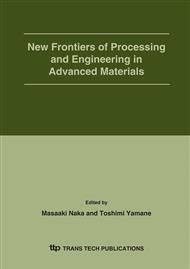p.351
p.361
p.367
p.373
p.379
p.385
p.393
p.399
p.405
Fabrications and Corrosion Resistance of Iron-Aluminum Alloy/High Carbon Steel Composites Prepared by Clad Rolling
Abstract:
The composite steel of iron-aluminum alloy and high carbon steel was fabricated by clad rolling, which process conditions were determined by the flow stress ratio between the constituents. Flow stress ratio of iron-aluminum alloy to carbon steel exhibits near unity at temperatures ranging from 873K to 1273K. Composite steel consisting of alloy/steel/alloy is successfully fabricated with about 70 % reduction in thickness, which demonstrates distinctive bending deformability. Clad plate is further rolled at room temperature to 150 µm in thickness with 98.3 % in reduction, and it is capable of winding without damage. The composite has shown significantly better high temperature oxidation resistance and corrosion resistance in a sulfuric acid than carbon steel. The dependency of corrosion resistance upon aluminum content of iron-aluminum alloy in an oxidation atmosphere is positive, whereas that in a sulfuric acid is negative. These results provide a strategy for the fabrication of functional composite steel.
Info:
Periodical:
Pages:
379-384
Citation:
Online since:
December 2005
Authors:
Keywords:
Price:
Сopyright:
© 2005 Trans Tech Publications Ltd. All Rights Reserved
Share:
Citation:


